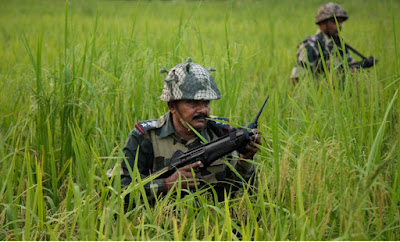[Earlier Saturday, Pakistani military
officers, including Lt. Gen. Asim Saleem Bajwa, the Pakistan Army spokesman,
gave a briefing in Baghsar, a picturesque, hilly village about 60 miles from
Mandhole. Pakistani officials said Thursday that the weapons fire had killed
two soldiers and wounded nine. General Bajwa reiterated Pakistan’s claims that
Indian troops had fired only small arms and mortars at Pakistani military
posts.]
By Salman Masood
MANDHOLE, Kashmir — The sound of gunfire
awoke Malik Rustam and his family around 4 a.m. on Thursday. Within minutes,
they headed for cover in a community bunker, as residents here in the
Pakistani-controlled portion of Kashmir have been trained to do.
Cross-border fire between Pakistani and
Indian troops is nothing new, but on Thursday, the Indian military claimed it
had carried out “surgical strikes” against four camps, including one near
Mandhole, used by militants intent on attacking the Indian-controlled portion
of Kashmir.
The village of Mandhole is along the banks of
the Poonch River, just across the Line of Control, the de facto border between
Pakistan and India in the disputed Kashmir region, which both sides claim in
its entirety. Indian military posts within 500 yards are visible.
On Saturday, Mr. Rustam, 22, pointed in that
direction and said the Indian troops never left their posts. “They are lying,”
he said. “They never crossed the L.O.C.” A group of villagers standing nearby
nodded in agreement.
As the latest escalation between India and
Pakistan threatened to break the fragile peace between the estranged,
nuclear-armed neighbors, residents in Mandhole seemed unusually calm.
Schools have remained open. Grocery stores
were serving customers, and buses moved slowly on patchy, winding roads along
the hilly terrain. As the afternoon sun sank behind the hills, several women
could be seen working in the fields, cutting grass and herding cattle.
Pakistan seemed eager to play down any
tensions in the area. Mr. Rustam and his fellow villagers had gathered on
Saturday to talk to a group of journalists who were ferried in by Pakistani
military helicopters to the Bhimber District of the Pakistani-controlled part
of Kashmir, about 100 miles from Islamabad, Pakistan’s capital.
But on the other side of the Line of Control,
in the village of Silikote, Raja Nazir, 37, a shopkeeper, said Saturday that
residents were still uneasy.
“There is fear in the air, and villagers are
on their toes fearing a retaliation by Pakistan after the strikes,” Mr. Nazir
said. His village is near the Indian Army base where militants killed at least
17 soldiers last month.
“Those who shout on TV for war should come
and live here with their children,” he added. “Then they will understand the
cost of war.”
Farooq Abdullah, a former chief minister of
Jammu and Kashmir State, appealed to both sides to avoid escalating the
conflict. “We hope cooler heads will prevail and the cease-fire of 2003 will be
upheld,” Mr. Abdullah said.
Earlier Saturday, Pakistani military
officers, including Lt. Gen. Asim Saleem Bajwa, the Pakistan Army spokesman,
gave a briefing in Baghsar, a picturesque, hilly village about 60 miles from
Mandhole. Pakistani officials said Thursday that the weapons fire had killed
two soldiers and wounded nine. General Bajwa reiterated Pakistan’s claims that
Indian troops had fired only small arms and mortars at Pakistani military
posts.
Indian troops opened fire at 2 a.m. on
Thursday at five locations over an area spanning 155 miles, he said. The
gunfire lasted about five hours, but the Indian troops never crossed the Line
of Control, and Pakistani troops returned fire.
India said that it had destroyed bases from
which militants carried out attacks in the part of Kashmir it controls, and
that it had inflicted heavy casualties on the militants. General Bajwa rejected
those claims.
“Where did all the dead bodies go?” he asked.
“Where were the funerals? Why haven’t the Indians produced any dead bodies if
they took them back?”
“Where is the damage?” General Bajwa said of
India’s claims of “surgical strikes,” adding that he welcomed an independent
inquiry. “Our side is open to the United Nations observers and journalists.”
He pointed toward the Samahni Valley, behind
the command post briefing area, and said there had been no civilian casualties
or damage to civilian property. At least 100,000 people live in the valley, he
said, where small clusters of houses are interspersed with agricultural tracts
of land.
Maj. Gen. Muhammad Chiragh Haider, the
commander of the 23rd Infantry Division of the Pakistan Army, joined General
Bajwa in the briefing.
General Haider has been posted in Kashmir for
the past two years and is a battle-hardened commander, having served in the
North Waziristan tribal region.
He expressed surprise at India’s claims. “We
are observing the cease-fire agreement in a very serious manner,” he said. “We
only respond if India opens fire.”
General Haider said the claims were “totally
incomprehensible,” adding, “A surgical strike took place against us, and we
were not even aware of it?”
Brig. Furqan Moazzam, a brigade commander,
echoed his fellow officers when asked how residents were coping with the
aftermath of the border clashes. “The valley is right in front of you,” he
said, pointing to the vast area. “Life is going on normally.”
Sameer Yasir contributed reporting from
Silikote, Kashmir.


